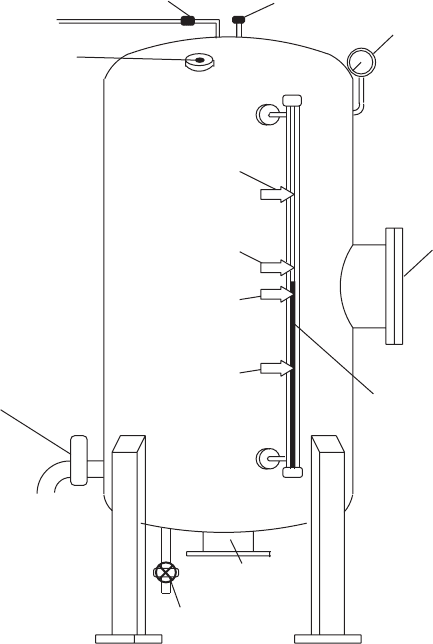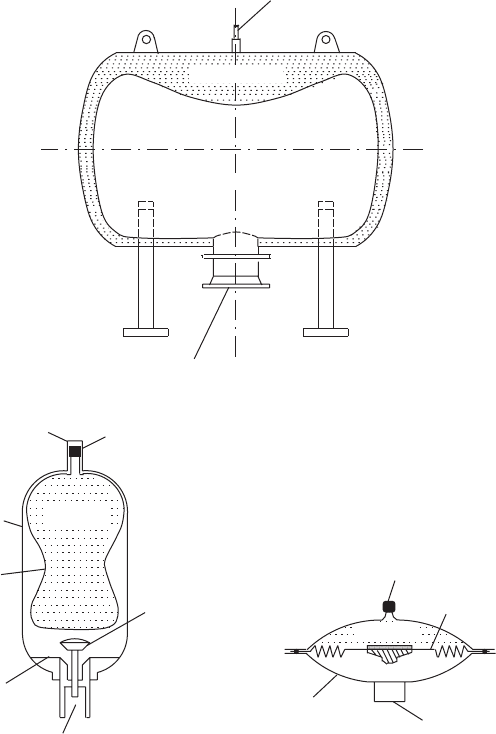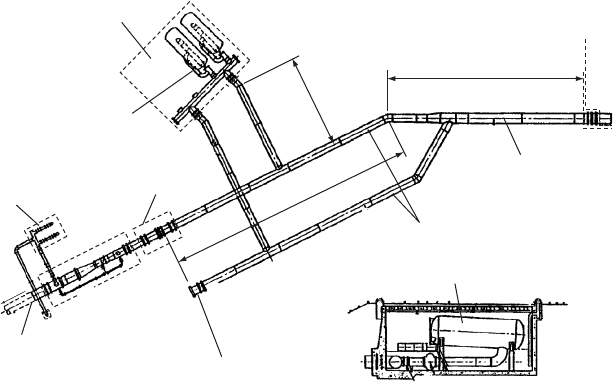Ellis,J. Pressure transients in water engineering, A guide to analysis and interpretation of behaviour
Подождите немного. Документ загружается.


The function gradient is then approximated by:
fn
0
ðÞ¼ffnð
2
Þfnð1Þg=f
2
1
g
A new estimate of is then obtained from:
n
¼fnð
n 1
Þ=fn
0
ð
n 1
Þ or
n
¼
n
þ
n 1
Example
The following values were used to illustrate the iterative solution which
can be easily programmed.
n ¼ 1, z ¼ 100 m, h
m
¼ 20 m, L ¼ 1000 m, D ¼ 1m, h
max
¼
h
m
expðz=h
m
Þ¼20 expð100=20Þ¼2968:3m, h
min
¼ z ¼ 100 m,
FVol
m
=V
p
¼20:0 3=785 ¼0:0764
Since it is only an estimate of peak head that is required, the process
can be truncated when a sufficient degree of convergence has been
achieved.
For the Kielder project, maximum upsurge pressure in the vessels was
estimated at 373.9 m absolute. The detailed analysis gave a maximum of
335 m absolute.
A12.5.3 Required throttling
To calculate the required amount of throttling to achieve a set maximum
upsurge pressure h
p
in the pressure vessel the equations are rearranged to
212
Table A12.3. Example values
h
p
fnðh
p
Þ fn
0
ðh
p
Þ h
p
2968.3000 2.97650330 0.0171504 173.550
2794.7476 1.29153690 0.0176300 73.259
2721.4884 1.30000000 0.0181000 71.722
2649.7700 0.77560800 0.0184300 42.085
2607.6854 0.47911000 0.0186210 25.730
2581.9556 0.28840000 0.0187400 15.392
2566.5636 0.17347730 0.0188070 9.224
2557.3397 0.10427650 0.0188500 5.532
2551.8077 0.06265840 0.0188800 3.320
2548.4881 0.03764300 0.0188910 1.993
2546.4954 0.02261160 0.0188990 1.196
2545.2990 0.01358150 0.0189050 0.718
2544.5806 0.00815727 0.0189090 0.431
2544.1492 — — —
Pressure transients in water engineering
yield an explicit solution for F.Againsetting ¼ h
m
=h
p
,then,
F ¼fzð 1Þh
m
lnðÞg=fVol
m
=V
p
ðz=2ð1 Þ
2
þ h
m
½1 þ ðlnðÞ1ÞÞg for n ¼ 1
and
F ¼fzð
ð1=nÞ
1Þh
m
=ð1 nÞð
ð1=n 1Þ
1Þg
=fVol
m
=V
p
ðz=2ð1
ð1=nÞ
Þ
2
þ h
m
ð1=ð2 nÞ
þ 1=ð1 nÞ
ð1=nÞ
½1=ð2 nÞ
ð1=n 1Þ
1ÞÞg
when n 6¼ 1 ðA12:11bÞ
Example
The desired value of maximum pressure h
p
in the vessel is selected.
Vol
m
¼ 3m
3
, V
p
¼ 785 m
3
, h
m
¼ 20 m, h
p
¼ 500 m, z ¼ 100 m.
n ¼ 1
F ¼f96:0 þ 64:377516g=f46:08 þ 16:624899g785=3
¼ 280:92
n ¼ 1:001
F ¼
f95:987117 þ 64:416g=f46:067633 þ 16:629134g785=3
¼ 280:62263
n ¼ 1:2
F ¼
f93:160096 þ 70:9976g=f43:394018 þ 17:219815g785=3
¼ 221:56
n ¼ 1:41
F ¼
f89:801103 þ 75:596298g=f40:321191 þ 17:373275g785=3
¼ 161:9722
The throttle at the vessels’ inlet in order to reduce the peak pressure
to 252 m absolute was estimated at 230 for n ¼ 1 while the detailed
analysis gave a throttle value of 125. Use of n > 1 gave higher values
of throttle coefficient, for example n ¼ 1:2 produced an estimated
throttle coefficient of 260.
213
Pressure vessels
A12.6 Pipeline system of varying cross-section
Where the pipeline is composed of more than one pipe of different
cross-section placed in series then it is necessary in calculations to sub-
stitute an equivalent single pipe having uniform characteristics.
The momentum of the mass of water in the equivalent pipeline must
remain the same as the momentum of water in the real system of pipes.
Length of the equivalent pipeline may be the same as the real system.
Velocity varies inversely as cross-sectional area, so that the equivalent
cross-sectional area A
eq
is:
A
eq
¼
X
L
i
=
X
ðL
i
=A
i
ÞðA12:12Þ
214
Pressure transients in water engineering
13
Further aspects of pressure
vessels
13.1 Pressure vessel types and their fittings
A range in pressure vessel types can be found with considerable variation
in size. Vessel capacity can range from volumes of individual installations
as small as 0.1 litres to multiple vessel systems of 1000 m
3
or more. These
vessels all provide some form of surge suppression function for a variety of
pipeline systems and liquids. One form of classification depends upon the
way in which the gas or air charge is maintained.
13.2 Vessels having an air—water interface
One large group of vessels comprises those in which the gas charge is in
direct contact with the liquid in the system (Fig. 13.1). The vessel
volume is split between the overlying gas charge and the stored liquid,
with transient analysis yielding the proportions of gas and liquid within
the tank. A gradual rise of liquid level may indicate absorption of gas by
the liquid or a leak in the air-filled part of the vessel. Maintenance of
an adequate gas charge within the vessel is essential if sufficient protection
is to be achieved. Many installations use an air compressor set or sets to
provide a supply of pressurised air to make up for any loss due to air
being absorbed by the liquid. For drinking water systems it is essential
to provide a high quality of purity in the air being delivered to the
vessel. In other instances a nitrogen gas charge may be used. This gas is
introduced to the vessel using cylinders of compressed gas which are
coupled to an inlet valve on the vessel.
13.2.1 Air compressors
The compressor sets should therefore be of an oil-free pattern such as
carbon or PTFE ring piston types or if standard reciprocating compressors
215

are used three-stage oil removal filters can be incorporated. These filters
will reduce oil carryover to <0.003 ppm where the temperature of air
flowing into the filter has been cooled to <308C after leaving the com-
pressor. Compressor capacity should be a balance between not allowing
the set to run too long and overheating, and too short not allowing the
set to reach a correct working temperature. Unmanned installations
should incorporate low oil level protection. Critical installations may
use duty and standby compressor sets.
While not absolutely necessary, air receivers are often installed in
surge vessel systems. Instead of the compressor delivering direct to
the vessel, a solenoid valve is included downstream of the receiver
and this opens to allow a flow of air into the vessel.
216
Inflow/outflow
connection
Water level indicato
r
Air inlet solenoid valve Air venting valve
Bourdon-type
pressure gauge
Manway
Silicon fluid filling point
Low-level alarm
Compressor stop
Compressor start
High-level alarm
Pressure relief valve
Drain valve
Fig. 13.1. Typical vertical vessel arrangement
Pressure transients in water engineering
13.2.2 Control of gas charge/liquid level
Several methods may be used to regulate the volume of gas within a
vessel, including:
(a) A single probe extending over the full operating range within the
vessel. The level of liquid against the probe produces a signal
proportional to the elevation of the gas—liquid interface. This
type is suitable where the liquid does not contain impurities
which might otherwise form a coating on the probe surface and
cause deterioration of the signal. Clearly this type is unsuitable
for sewage and dirty water.
(b) A set of probes of different lengths which correspond with the alarm
levels and compressor start/stop levels. Being activated purely on
contact with the liquid surface, this arrangement can be used
with sewage and other contaminated liquids.
(c) Differential pressure measurement can be used to signal changing
liquid level.
(d) Combined sight glasses and level indication, for example using a
magnetic float. As level rises a series of magnetic switches flip
over showing a change of colour, often red to indicate liquid.
With level probes and pressure measurements a sight glass should
also be included for rapid visual checking of level. In the event of
damage to the sight glass, valves at the top and bottom vessel/glass con-
nections should close automatically to prevent loss of vessel function.
Some vessel manufacturers such as Quietflo offer the option of
adding silicon-based absorption-retardant fluid to the tank. This
forms a barrier membrane on top of the liquid and reduces the rate of
gas loss. Silicon fluid use is approved by the food industry.
Liquid level within the vessel may vary considerably during a surge
event. Level may range outwith the compressor start/stop positions and
even the high and low level alarm points. In the event that a liquid
level above the compressor start level is indicated, a time delay is incor-
porated to prevent start during a transient event. This delay can be deter-
mined by the transient analysis with a default setting of say 5 min set by
the vessel supplier. Site adjustment of the delay should be possible.
The compressor should start operation or the inlet solenoid valve
should open when liquid level exceeds the compressor start level. Air
inflow to the vessel should continue until liquid level has fallen to
the compressor stop/solenoid valve close position. The compressor
should be arranged to stop when the liquid volume has been reduced
by around 5%.
217
Further aspe cts of pressure vessels
Where a pumping system operates over a range of delivery pressures,
say high daytime pressure and lower night time pressure, the vessel gas
charge will expand as pressure drops, leaving a reduced water volume in
the vessel. To restore sufficient water volume, some air can be vented
from the vessel to ensure sufficient water is contained for surge pur-
poses. Transient analysis will yield information on the necessary
volumes of air/water over the range of operating pressure conditions.
If a large installation requires several vessels for surge protection
then, provided the vessels are all on one level, they can be treated as
one vessel controlled by a single-level sensing system. A single solenoid
valve controls air flow to all vessels, ensuring that the same pressure is
achieved throughout.
The same compressor/air receiver system may be used to supply air to
vessels serving several mains at the same pumping station. These mains
may operate at different pressures, with each main requiring its own
transient analysis. Each vessel will have its own level sensing system
and solenoid-operated air inlet valve. If a vessel is receiving air through
its valve and a second vessel requires air then the first vessel should
complete filling and its solenoid valve shut before the second vessel
starts to receive air. Ideally, two solenoid valves should be installed in
parallel at each vessel to provide backup in the event of a valve failure.
13.2.3 Other vessel fittings
To allow access for inspection and maintenance, a manway should be
included in the vessel; typically this will be around 500 mm diameter.
A drain valve should be sited at the lowest point on the vessel for
emptying.
A Bourdon pressure gauge can be installed towards the top of the
vessel connected to the gas charge.
A pressure relief valve can be included in the lower part of the vessel
so that if part of the gas charge has been lost and transient pressures
exceed the normal maximum surge level, this valve will open to prevent
further significant excess pressure rise. Some suppliers include a relief
valve on top of the vessel with air being discharged but this allows
the remaining gas charge to be further depleted.
Vessels installed out of doors may require winter protection,
especially if in an exposed location subject to wind chill when tempera-
ture can fall to 258C. Tanks and all exposed connections should be
lagged and trace heated as shown in Fig. 12.19. This also applies to
sight glasses, as freezing can cause failure of the tube. System design
218
Pressure transients in water engineering
should consider site conditions carefully and all failure conditions which
might develop.
A circulation system can be included in those larger installations
containing a substantial volume of water in the vessel. Eventually the
water can become stale unless an arrangement to change the water is
incorporated. A small pump and pipework system providing about
5 litres/min (7 m
3
/day) will ensure that water in the vessel remains
sweet.
13.3 Bladder vessels
An alternative type of vessel uses an elastomer bladder, usually
neoprene, contained within the vessel. A valve is connected to the
top of the vessel to allow recharging with gas. This can be done using
a portable cylinder containing either nitrogen or compressed air.
Response of a vessel of this type can be analysed in much the same
way as a conventional vessel and will be subject to some of the same
uncertainties as the conventional vessel analysis such as the validity
of the gas law used.
While a considerable variation in design is evident in bladder-type
vessels, they have the common feature of having a membrane
separating the liquid and gas components. In addition to finding
application as straightforward transient protection devices, many
bladder-type installations are used as pulsation dampers upstream and
downstream of positive displacement pumps and to compensate for
temperature changes within closed pipeline systems. By providing
complete separation of gas and liquid, the possibility of gas charge
loss through absorption is eliminated and with it the requirement for
a compressor and level monitoring system. The life expectancy of the
bladder may be considered a possible drawback.
Figure 13.2 illustrates three forms of bladder vessel. Figure 13.2a is a
fairly typical arrangement of vessel available for surge suppression duty.
The bladder contains the liquid volume which does not come into
contact with the vessel walls. This has some benefit in reducing main-
tenance of the inside of the vessel. A nitrogen gas charge fills the space
between bladder and vessel wall. A gas filling connection is provided on
top of the vessel with filling achieved using a compressed nitrogen
bottle. Vessel volumes available as standard may range from 8 to
50 000 litres.
Figure 13.2b illustrates a smaller type of accumulator. In this case the
bladder contains the nitrogen charge with the liquid filling the space
219
Further aspe cts of pressure vessels

between the bladder and the vessel walls. As pressure drops and the gas
expands, then to prevent possible expansion of the bladder out of the
vessel a poppet valve is included which is pushed shut by the expanding
bladder thus preventing the bladder being damaged. Its chief function is
to store fluid under pressure. Stored fluid is then released to the pipeline
circuit to supplement pump output and to absorb pressure peaks and
shocks generated elsewhere in the system.
220
(b) (c)
Gas filling connection
Air or nitrogen
Liquid-filled bladder
(a)
Outlet to pipeline
Protective cap
Non-return
gas valve assembly
Poppet valve
Liquid inlet/outlet
Anti-extrusion ring
Separator
bladder
Steel shell
Nitrogen
Nitrogen
Gas charging valve
PTFE diaphragm
Shell in stainless steel,
polypropylene and PVC
Unrestricted
inlet–outlet port
Fig. 13.2. Bladder vessel types
Pressure transients in water engineering

Figure 13.2c shows a small diaphragm pulsation damper. It comprises
a dished shell in two halves. The upper half contains a gas charging
valve and the lower the inlet/outlet connection. Between these
halves is clamped a diaphragm, possibly of PTFE. Bonded in the
centre of the circular diaphragm is a ‘button’. In the event of pressure
drop the gas expands and the diaphragm moves downwards. The
button will eventually make contact with the inlet/outlet port,
preventing further movement and avoiding damage to the diaphragm.
This small vessel is used as a pulsation damper and typical volumes
may range from 0.1 to 30 litres.
13.4 Positioning a pressure vessel
Siting of pressure vessels is important in a number of respects. Consider
the layout of pressure vessels at Riding Mill pumping station as shown in
Fig. 13.3. The vessels are offset from the main by about 30 m. Following
pump trip, a rarefaction pressure wave from the pumping station
travels to the vessel connection. The wave will split with part conti-
nuing along the main while a second component propagates along
the vessel connection. Only when this second component has been
reflected from the vessels in the form of a compression wave, and
returns to the main, will the vessels start to influence events in the
221
Section of air vessel chamber
Air vessel chamber
3 No. 403 mm orifice
plates in series in 813 mm
inlet bypass line
Pumping station building
45.0 m
2220 mm o.d.
1820 mm o.d.
Air vessel 3.5 m o.d. ¥ 11.0 m
Sight
glass
Max WL
Min WL
Connection for
future pumping main
21.4 m
57.25 m
Flowmeter
chamber
Pumping main
2000 mm o.d.
Flow
Stilling well
outlet chamber
Fig. 13.3. Pressure vessels at Riding Mill
Further aspe cts of pressure vessels
